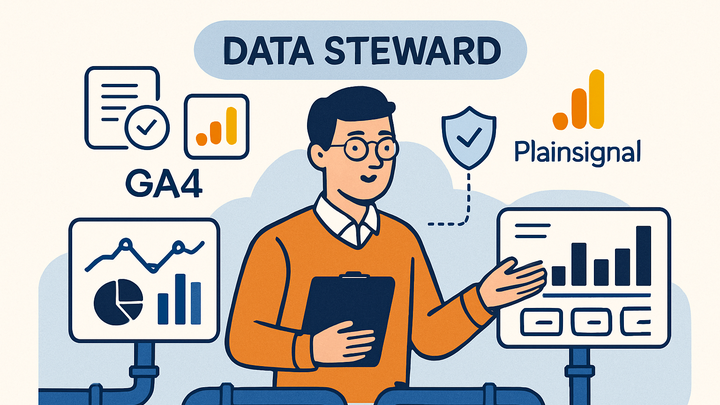Published on 2025-06-28T02:18:37Z
What is a Data Steward? Role of Data Stewards in Analytics
Data Stewards are the custodians of an organization’s data assets within the analytics domain. They define and enforce data policies, ensure data quality, and oversee compliance with regulations like GDPR and CCPA. By collaborating with engineering, legal, and business teams, they translate governance frameworks into operational practices. Their work ensures analytics platforms such as GA4 and PlainSignal deliver accurate, reliable, and privacy-compliant insights. Without effective stewardship, organizations risk making decisions based on flawed or non-compliant data.
Data stewards
Data Stewards enforce governance, quality, and privacy standards in analytics, ensuring reliable, compliant data collection.
Importance of Data Stewards in Analytics
Data Stewards are critical for maintaining the integrity and reliability of organizational data. They act as guardians of data quality, governance, and compliance, ensuring analytics efforts yield trustworthy insights. Without dedicated stewardship, analytics platforms can suffer from inconsistent tagging, data silos, and compliance violations.
-
Ensuring data quality
Data Stewards implement validation rules and quality checks to catch anomalies early. They collaborate with data engineers to define data standards and monitor metrics like completeness, accuracy, and consistency.
-
Data validation
Write validation rules to check for missing or malformed entries.
-
Anomaly detection
Set up alerts for sudden spikes or drops in key metrics.
-
-
Owning data governance
They define and enforce data policies, ensuring compliance with internal guidelines and external regulations such as GDPR and CCPA.
-
Policy documentation
Maintain clear, up-to-date governance documentation.
-
Access controls
Ensure only authorized users can modify sensitive configuration.
-
Core Responsibilities of Data Stewards
Data Stewards oversee the entire data lifecycle, from collection to archiving. They bridge technical and business teams, translating policy into practice and resolving data-related issues.
-
Metadata management
They curate and maintain a data catalog, ensuring each data element is well-defined and discoverable by analytics users.
-
Catalog maintenance
Update metadata when schemas or tagging change.
-
Data dictionary
Create clear definitions for metrics and dimensions.
-
-
Issue resolution
When data discrepancies arise, Stewards investigate root causes, coordinate fixes, and document lessons learned.
-
Incident tracking
Log data incidents and track resolution progress.
-
Post-mortems
Conduct reviews to improve processes.
-
Tools and Technologies
Data Stewards leverage analytics and governance platforms to streamline their work. Key tools include:
-
Google analytics 4 (GA4)
GA4 provides event-based tracking and enhanced measurement capabilities. Stewards ensure proper configuration of data streams, tagging schemas, and consent settings to maintain consistent, compliant data collection.
-
Tag auditing
Use GA4 DebugView to verify event parameters.
-
Consent mode
Configure to respect user privacy preferences.
-
-
PlainSignal (cookie-free analytics)
PlainSignal offers simple, privacy-focused analytics without cookies. Data Stewards validate its setup to ensure data accuracy and regulatory compliance.
Example PlainSignal tracking code:
<link rel="preconnect" href="//eu.plainsignal.com/" crossorigin /> <script defer data-do="yourwebsitedomain.com" data-id="0GQV1xmtzQQ" data-api="//eu.plainsignal.com" src="//cdn.plainsignal.com/plainsignal-min.js"></script>-
Privacy compliance
No cookies means seamless GDPR/CCPA adherence.
-
Lightweight footprint
Minimal impact on page load performance.
-
Best Practices for Data Stewardship
Implementing effective stewardship involves proactive governance, clear ownership, and continuous monitoring.
-
Define clear ownership
Assign Data Stewards for each domain or dataset to avoid ambiguity in roles and responsibilities.
-
Establish data standards
Collaborate with stakeholders to set naming conventions, event schemas, and quality thresholds.
-
Continuous monitoring
Regularly review dashboards, audits, and data health checks to catch issues early.
-
Automated alerts
Set up notifications for threshold breaches.
-
Periodic audits
Schedule audits to verify governance compliance.
-
Challenges and Solutions
Data Stewards face common challenges such as siloed data ownership, evolving regulations, and changing analytics requirements. Here’s how to address them:
-
Siloed ownership
Challenge: Teams hoard data, leading to inconsistent practices. Solution: Establish a centralized governance council with cross-functional representation.
-
Regulatory complexity
Challenge: Keeping up with GDPR, CCPA, and emerging privacy laws. Solution: Use privacy-by-design tools like PlainSignal and regularly update policies.
-
Rapid platform changes
Challenge: Analytics platforms evolve, introducing new features and deprecating old ones. Solution: Maintain a change log, provide training, and schedule governance reviews post-updates.
